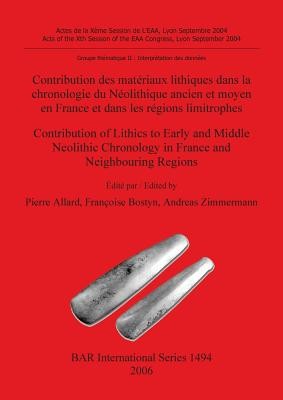
- We will send in 10–14 business days.
- Publisher: British Archaeological Reports Oxford Ltd
- Year: 2006
- Pages: 83
- ISBN-10: 1841719250
- ISBN-13: 9781841719252
- Format: 21 x 29.7 x 0.6 cm, minkšti viršeliai
- Language: English
- SAVE -10% with code: EXTRA
Contribution des matériaux lithiques dans la chronologie du Néolithique ancien et moyen en France et dans les régions limitrophes / Contribution of Lithics to Early and Middle Neolithic Chronology in France and Neighbouring Regions (e-book) (used book) | bookbook.eu
Reviews
Description
Groupe thématique II: Interprétation des données
Actes de la Xème Session de L'EAA, Lyon Septembre 2004 / Acts of the Xth Session of the EAA Congress, Lyon September 2004
Seven papers from the session on Lithics and the Early and Middle Neolithic Chronology in France given at the EAA conference in Lyon in 2004. Work on lithic materials in the widest sense has developed considerably over the last two decades, leading to an almost complete renewal of methods and objectives. From the 1980s onwards there emerged methods which have become classic: investigation of raw materials, creation of reference collections (lithothèques), characterization of procurement modes, studies oftechnology and analyses of use-wear. Relative chronology, mainly established through study of decorated ceramics, is still an essential aspect of our discipline and new data have stimulated debate on the relations between various cultural groups defined on stylistic grounds. This volume aims to review the contribution of lithic studies in both France and neighbouring regions for establishing the cultural sequences of the early and middle Neolithic.
EXTRA 10 % discount with code: EXTRA
The promotion ends in 21d.02:52:32
The discount code is valid when purchasing from 10 €. Discounts do not stack.
- Publisher: British Archaeological Reports Oxford Ltd
- Year: 2006
- Pages: 83
- ISBN-10: 1841719250
- ISBN-13: 9781841719252
- Format: 21 x 29.7 x 0.6 cm, minkšti viršeliai
- Language: English English
Groupe thématique II: Interprétation des données
Actes de la Xème Session de L'EAA, Lyon Septembre 2004 / Acts of the Xth Session of the EAA Congress, Lyon September 2004
Seven papers from the session on Lithics and the Early and Middle Neolithic Chronology in France given at the EAA conference in Lyon in 2004. Work on lithic materials in the widest sense has developed considerably over the last two decades, leading to an almost complete renewal of methods and objectives. From the 1980s onwards there emerged methods which have become classic: investigation of raw materials, creation of reference collections (lithothèques), characterization of procurement modes, studies oftechnology and analyses of use-wear. Relative chronology, mainly established through study of decorated ceramics, is still an essential aspect of our discipline and new data have stimulated debate on the relations between various cultural groups defined on stylistic grounds. This volume aims to review the contribution of lithic studies in both France and neighbouring regions for establishing the cultural sequences of the early and middle Neolithic.


Reviews